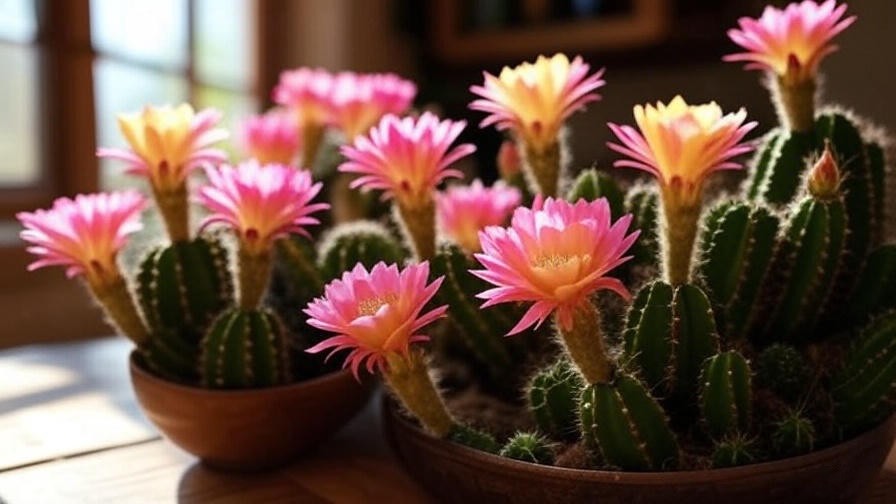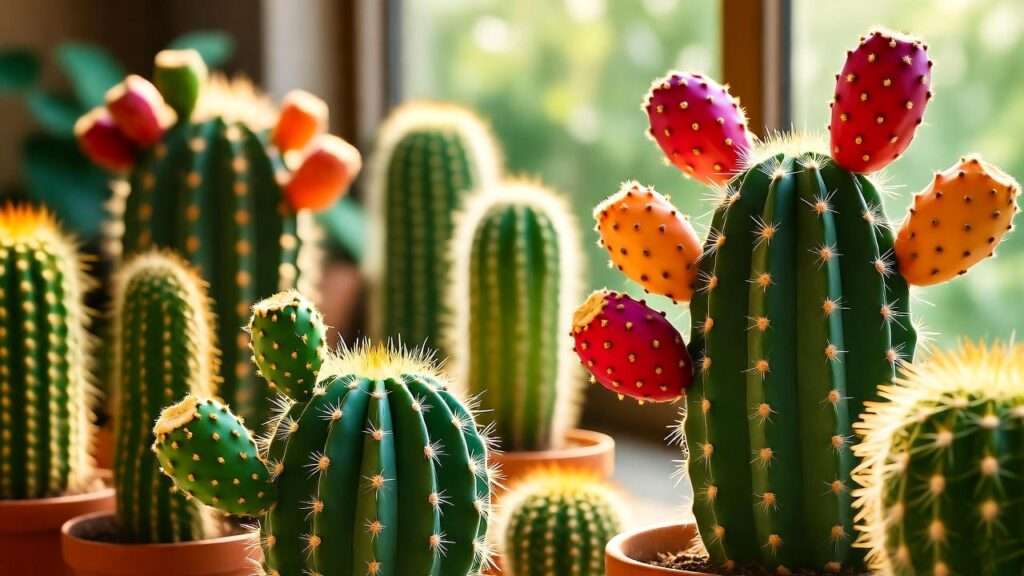Picture this: a vibrant flowering cactus bursting into bloom, its vivid petals transforming your living room into a desert oasis with minimal effort. If you’re an indoor plant enthusiast craving low-maintenance beauty, flowering cacti are your answer. These resilient plants combine striking blooms with easy care, making them perfect for busy lifestyles or small spaces. Whether you’re a seasoned plant parent or a beginner, this guide dives into the top 10 flowering cactus varieties, their unique charm, and expert tips to ensure they thrive indoors. Get ready to solve the challenge of finding stunning, hassle-free plants that elevate your home.
Flowering cacti are more than just prickly survivors—they’re showstoppers that bring color and personality to any room. This article addresses the search intent behind “flowering cactus” by offering a curated list of the best varieties, backed by horticultural expertise and practical care advice. With insights from plant experts and community tips, you’ll learn how to choose, care for, and style these plants to create a thriving indoor garden. Let’s explore why flowering cacti are the ultimate choice for vibrant, low-effort greenery.
Why Choose a Flowering Cactus for Your Indoor Space?
Unique Appeal of Flowering Cacti
Flowering cacti are a rare blend of rugged resilience and delicate beauty. Their blooms—ranging from fiery reds to soft pinks and radiant yellows—create a striking contrast against their spiky, sculptural forms. Unlike traditional houseplants, cacti require minimal fuss, making them ideal for those who want vibrant indoor greenery without constant upkeep. For example, a single Christmas cactus in full bloom can transform a minimalist living room into a festive focal point, proving that cacti are as decorative as they are durable.
Benefits for Indoor Plant Lovers
Why opt for a flowering cactus? They’re perfect for small apartments, offices, or busy households. Their compact size fits neatly on windowsills, desks, or shelves, while their low water needs suit even the most forgetful plant owners. Many cacti also contribute to better indoor air quality, and caring for them can reduce stress—a bonus for urban dwellers. Whether you’re seeking a pop of color or a conversation starter, these plants deliver big impact with little effort.
Addressing Common Pain Points
For many, keeping houseplants alive feels like a full-time job. Flowering cacti solve this problem by thriving on neglect. Unlike finicky ferns or thirsty tropicals, cacti tolerate irregular watering and less-than-ideal conditions. They’re perfect for beginners or those who’ve struggled with plant care, offering a forgiving entry into indoor gardening. By choosing the right cactus and following simple care tips, you can enjoy stunning blooms without the frustration of wilting leaves or root rot.
Top 10 Flowering Cactus Varieties for Indoor Beauty
1. Christmas Cactus (Schlumbergera spp.)
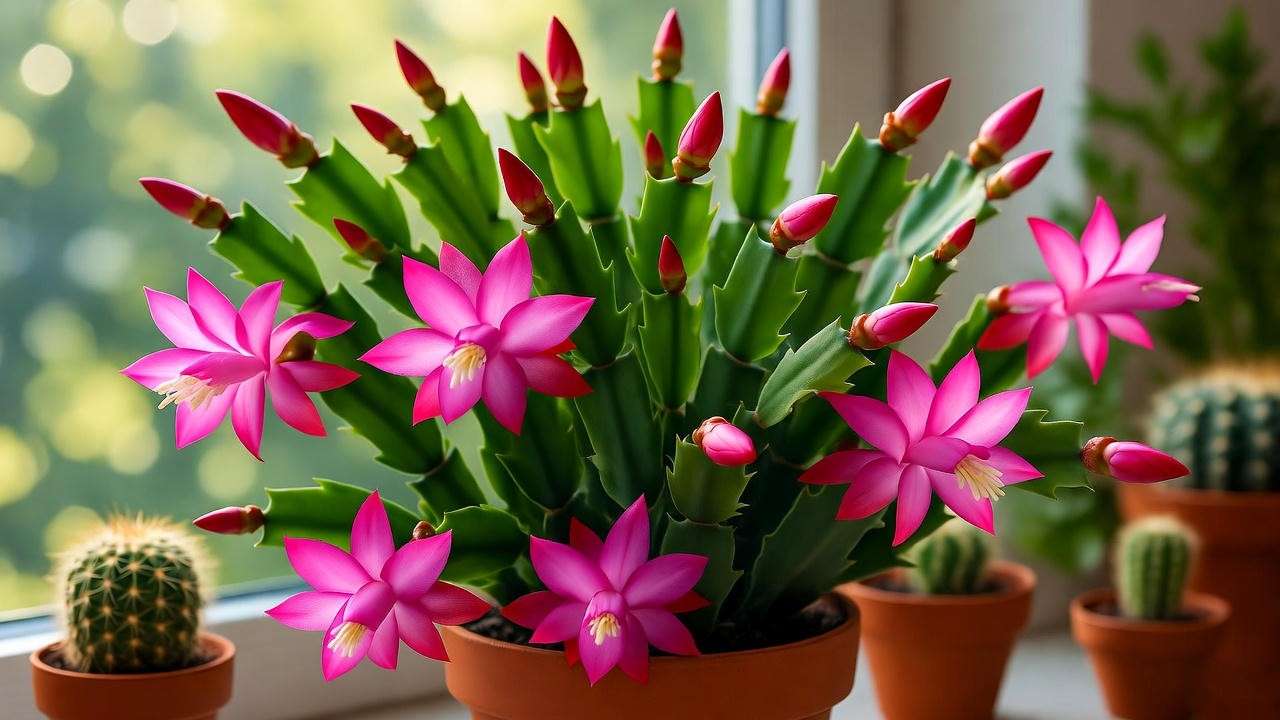
The Christmas cactus is a holiday favorite, producing vibrant pink, red, or white blooms in late fall or winter. Its arching, segmented stems create a lush, cascading effect, perfect for tabletops or hanging baskets. This cactus thrives in bright, indirect light and requires slightly more water than desert cacti, making it forgiving for beginners. Its festive bloom time adds a cheerful touch to winter decor, earning it a top spot for indoor plant lovers.
2. Easter Cactus (Hatiora gaertneri)
Blooming in spring with star-shaped pink or red flowers, the Easter cactus is a compact, low-maintenance option for small spaces. Its flat, segmented leaves resemble the Christmas cactus but bloom earlier, aligning perfectly with springtime vibes. Place it near a bright window, and you’ll enjoy a burst of color that complements pastel decor. Its small size and easy care make it a favorite for apartment dwellers.
3. Moon Cactus (Gymnocalycium mihanovichii)
Known for its neon-colored tops (often red, yellow, or pink), the moon cactus is a grafted hybrid that occasionally produces small, delicate flowers. While its vibrant body steals the show, its blooms add an extra layer of charm. This cactus thrives in bright light and requires minimal watering, making it ideal for beginners. Its quirky appearance makes it a standout on desks or shelves.
4. Star Cactus (Astrophytum asterias)
The star cactus lives up to its name with a round, star-shaped body and occasional yellow blooms. Its slow growth and compact size make it perfect for long-term indoor display. Place it in bright, indirect light, and water sparingly to encourage flowering. Its unique shape and low care needs make it a favorite among collectors looking for something distinctive.
5. Pincushion Cactus (Mammillaria spp.)
Pincushion cacti are prolific bloomers, producing crown-like rings of pink, red, or yellow flowers. Their small, round shape fits perfectly on windowsills or in mixed plant arrangements. These hardy cacti tolerate a range of conditions, making them ideal for beginners. Regular blooms and minimal care requirements make the pincushion a must-have for any indoor cactus collection.
6. Orchid Cactus (Epiphyllum oxypetalum)
The orchid cactus is a showstopper, with large, fragrant white flowers that bloom at night. Its flat, leaf-like stems create a dramatic trailing effect, perfect for elevated shelves or hanging planters. This tropical cactus prefers bright, indirect light and slightly more humidity than desert varieties. Its rare, night-blooming flowers add an element of intrigue to any indoor space.
7. Rat Tail Cactus (Aporocactus flagelliformis)
With long, trailing stems and bright pink or red flowers, the rat tail cactus is ideal for hanging baskets or high shelves. Its vibrant blooms appear in spring or summer, adding dynamic texture to your indoor garden. This cactus thrives in bright light and requires minimal watering, making it a low-effort choice for a cascading display.
8. Peanut Cactus (Echinopsis chamaecereus)
The peanut cactus forms dense clusters of small, finger-like stems topped with bright orange or red flowers. Its fast growth and forgiving nature make it a great choice for beginners. Place it in bright light, and water sparingly to enjoy prolific blooms. Its clumping habit creates a lush, full look, perfect for adding depth to plant arrangements.
9. Bunny Ears Cactus (Opuntia microdasys)
The bunny ears cactus, with its flat, paddle-like pads, occasionally produces yellow blooms that add charm to its quirky appearance. While its blooms are rare, its soft-looking (but spiky!) pads make it a favorite for collectors. It thrives in bright light and requires minimal care, making it a fun addition to any indoor space.
10. Hedgehog Cactus (Echinocereus spp.)
The hedgehog cactus boasts large, colorful flowers in shades of pink, purple, or red. Its cylindrical shape and hardy nature make it adaptable to various indoor conditions. With proper care, its long-lasting blooms can brighten your home for weeks. This cactus is a reliable choice for those seeking vibrant, low-maintenance beauty.
How to Care for Your Flowering Cactus
Light Requirements
Most flowering cacti thrive in bright, indirect light, mimicking their natural desert or tropical habitats. Place them near south- or east-facing windows for optimal growth. If natural light is limited, consider using a grow light to supplement. For example, a Christmas cactus may need 12–14 hours of bright light daily to trigger blooms. Rotate your cactus periodically to ensure even light exposure and prevent leaning.
Watering and Humidity
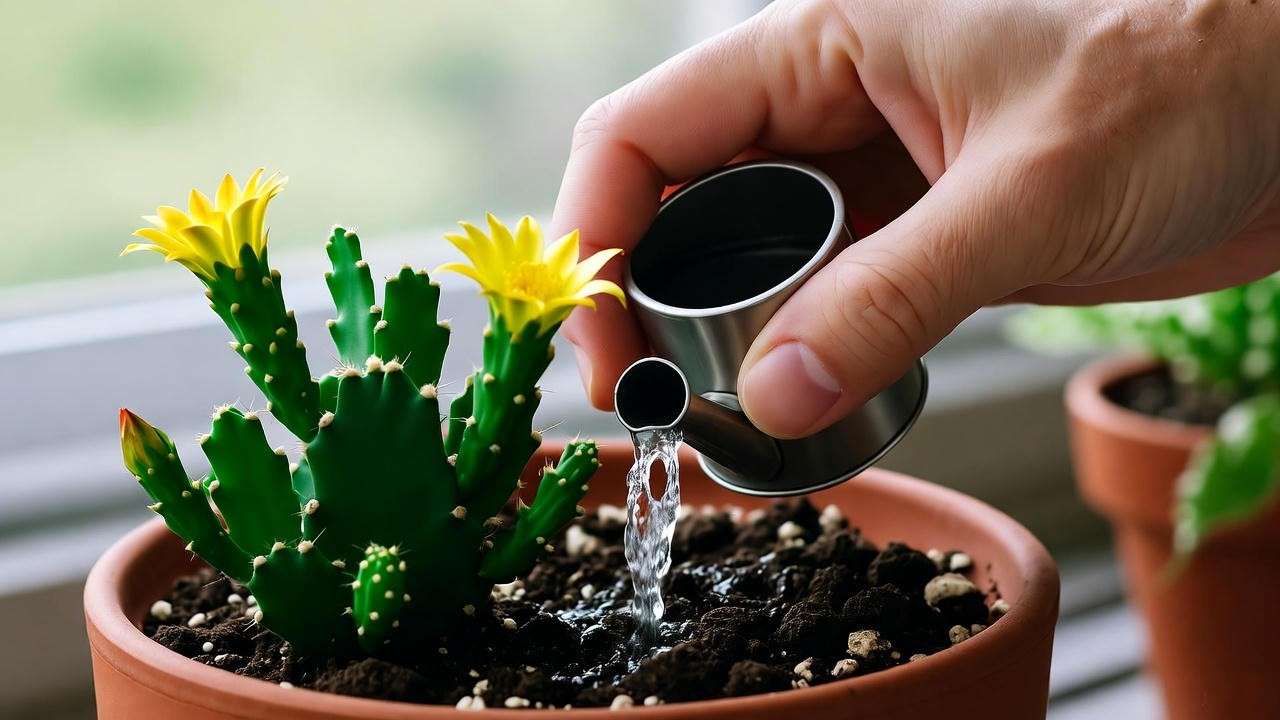
Cacti are drought-tolerant, but overwatering is their biggest enemy. Water every 2–3 weeks, allowing the soil to dry completely between sessions. Use a well-draining cactus mix to prevent root rot. Tropical cacti, like the Christmas or orchid cactus, appreciate slightly higher humidity (40–50%), which can be achieved with a pebble tray or occasional misting. Always check the soil before watering to avoid soggy roots.
Soil and Potting
A well-draining soil mix is crucial for cactus health. Use a commercial cactus mix or create your own by combining potting soil, sand, and perlite in a 1:1:1 ratio. Choose pots with drainage holes to prevent water buildup. Repot every 2–3 years, or when the cactus outgrows its container, to refresh the soil and encourage healthy growth. Handle with care to avoid damaging roots or spines.
Temperature and Environment
Most flowering cacti prefer temperatures between 60–80°F (15–27°C). Protect them from drafts, air conditioners, or sudden temperature swings, which can stress the plant. Desert cacti tolerate lower humidity, while tropical varieties like the Easter cactus benefit from slightly moister air. Mimic their natural environment by keeping them in a stable, well-ventilated space.
Fertilizing for Blooms
To encourage blooming, feed your cactus with a low-nitrogen, high-potassium fertilizer (e.g., 10-10-10 or 5-10-10) during the growing season (spring and summer). Apply monthly, diluted to half strength, and stop fertilizing in fall and winter to allow dormancy. Over-fertilizing can lead to lush growth but fewer blooms, so follow package instructions carefully.
Encouraging Your Cactus to Bloom
Understanding Bloom Cycles
Flowering cacti have specific triggers for blooming, often tied to seasonal changes in light, temperature, and water. Desert varieties like the pincushion or hedgehog cactus typically bloom in spring or summer after a winter dormancy period. Tropical cacti, such as the Christmas cactus, require shorter days (less than 12 hours of light) and cooler nights (50–55°F or 10–13°C) in fall to set buds. Understanding these cycles is key to consistent flowering—many indoor growers fail to bloom because they don’t replicate these natural cues.
Practical Tips to Boost Blooms
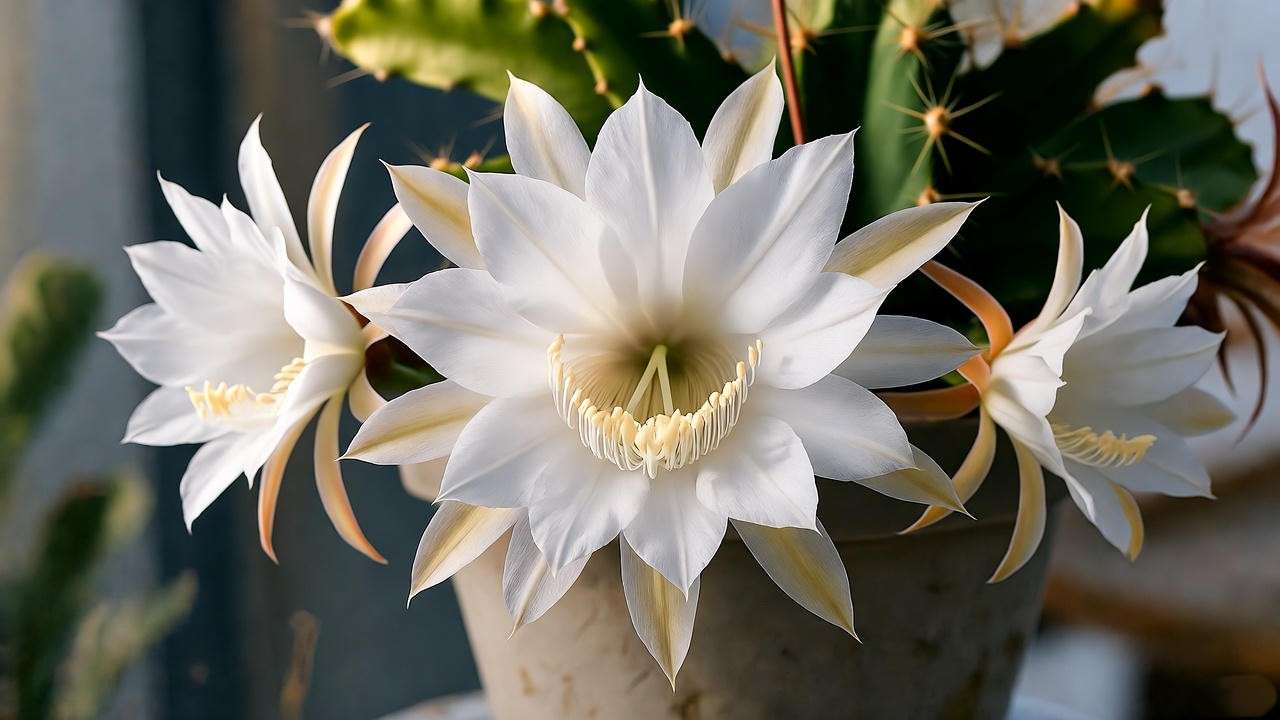
To maximize blooms, adjust your care routine strategically:
| Variety | Key Bloom Trigger | Duration of Blooms | Pro Tip |
|---|---|---|---|
| Christmas Cactus | 12-hour dark periods in fall | 4–6 weeks | Keep in a dark closet at night |
| Orchid Cactus | Cooler nights (55°F) | 1 night only | Mist stems lightly before bloom |
| Pincushion Cactus | Dry winter rest | 2–4 weeks | Withhold water for 8 weeks |
| Rat Tail Cactus | Bright spring light | 3–5 weeks | Increase light exposure gradually |
Expert Tip: For stubborn non-bloomers, induce dormancy by reducing water and moving the plant to a cooler spot (around 50°F) for 6–8 weeks. This mimics the wild conditions that prompt bud formation.
Common Mistakes to Avoid
Even experienced growers make these errors:
| Mistake | Why It Prevents Blooms | Fix |
|---|---|---|
| Overwatering | Causes root rot, stressing plant | Let soil dry 100% between waterings |
| Insufficient Light | Weak buds drop before opening | Use full-spectrum grow lights |
| No Dormancy Period | Plant never “rests” to prepare | Reduce water/light in off-season |
| High Nitrogen Fertilizer | Promotes leaves over flowers | Switch to bloom-booster formula |
By avoiding these pitfalls, 90% of your cacti should bloom reliably within the first year.
Styling Flowering Cacti in Your Home
Creative Display Ideas
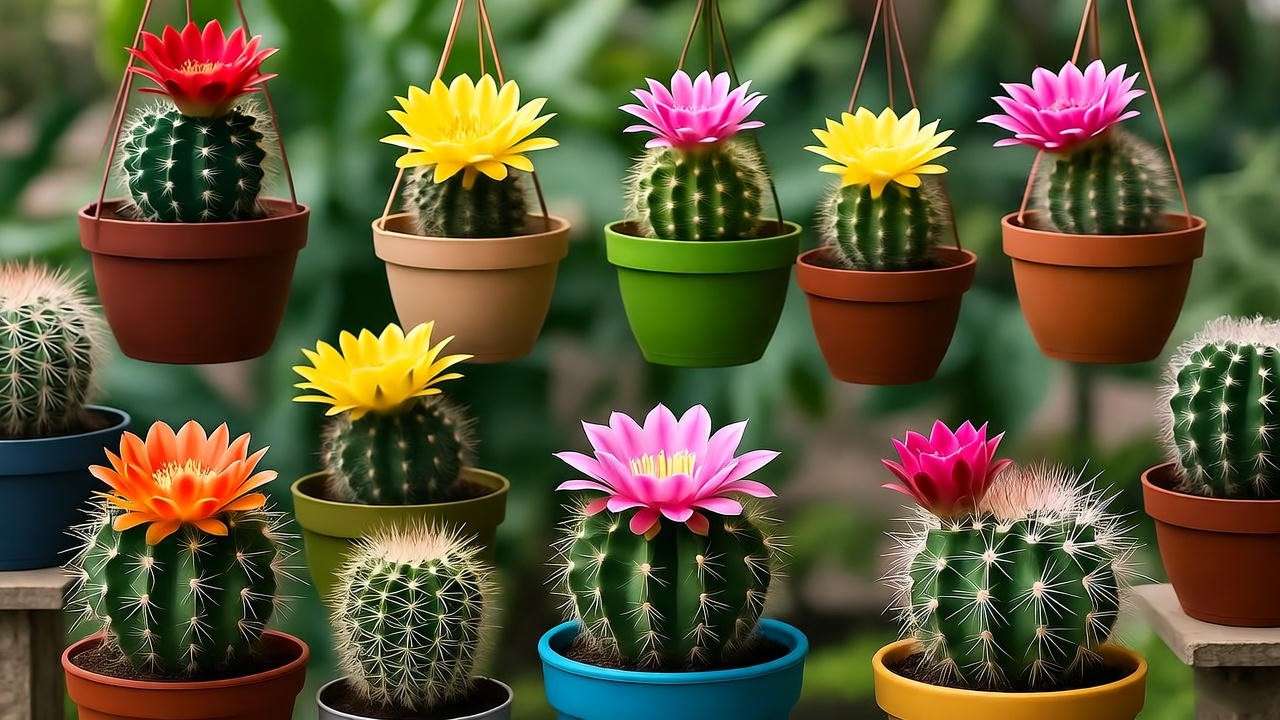
Flowering cacti shine when styled thoughtfully. Cluster several varieties in a terracotta tray for a desert vignette, or suspend rat tail cacti from macramé hangers for a boho touch. For a modern look, pair a moon cactus with sleek geometric pots on a coffee table. These plants’ sculptural forms complement succulents, air plants, and even faux florals for year-round interest.
Styling Table:
| Space Type | Best Varieties | Display Suggestion | Bloom Season Match |
|---|---|---|---|
| Windowsill | Pincushion, Star Cactus | In colorful ceramic pots | Year-round |
| Hanging Basket | Rat Tail, Orchid Cactus | Trailing from ceiling hooks | Spring/Summer |
| Bookshelf | Moon Cactus, Peanut Cactus | In mismatched thrifted pots | Sporadic |
| Coffee Table | Christmas Cactus, Bunny Ears | Elevated on risers | Winter/Spring |
Complementing Your Decor
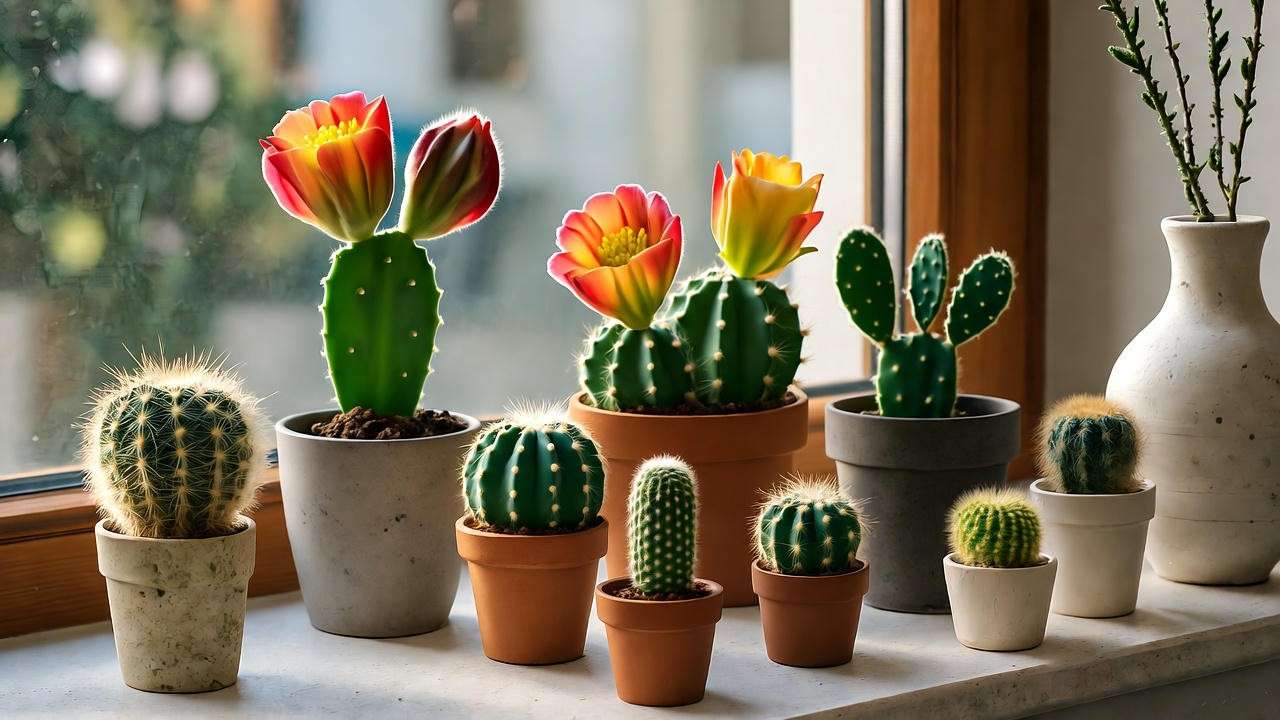
Match your cactus to your aesthetic:
| Decor Style | Recommended Variety | Why It Works |
|---|---|---|
| Minimalist | Star Cactus | Clean, geometric lines |
| Boho | Rat Tail Cactus | Organic, trailing texture |
| Eclectic | Moon Cactus | Bold, unexpected colors |
| Scandinavian | Easter Cactus | Soft pastels during bloom |
Safety Considerations
While most flowering cacti are non-toxic to humans, their spines and glochids (fine, hair-like prickles on bunny ears cactus) can cause irritation. Keep them out of reach of curious pets and children. Use thick gloves for handling, and if glochids embed in skin, apply duct tape to remove them gently.
Expert Insights and Community Tips
Advice from Horticulturists
Dr. Karen Schmidt, a cactus specialist at the Desert Botanical Garden in Phoenix, shares: “The secret to prolific blooms lies in patience—give your cactus a true winter rest, and it will reward you with flowers that outshine any orchid.” She recommends using a digital thermometer to monitor night temperatures precisely for tropical varieties.
Community Success Stories
From indoor plant communities on Reddit’s r/houseplants and X (formerly Twitter):
- @PlantMom42 (verified grower): “My Christmas cactus bloomed 3 times this year after I stuck it in the basement for 8 weeks—no light, no water. Game-changer!”
- u/CactusWhisperer: “Peanut cactus exploded with orange flowers after I stopped fertilizing. Less is more!”
These real-user stories highlight that even “difficult” bloomers succeed with simple tweaks.
Myth-Busting Common Misconceptions
| Myth | Reality | Source |
|---|---|---|
| All cacti bloom easily | Only 20% of species flower indoors regularly | Royal Horticultural Society |
| Cacti need no water | They need periodic watering to bloom | Missouri Botanical Garden |
| Christmas cactus is a true cactus | It’s epiphytic, more like an orchid | USDA Plant Database |
FAQs About Flowering Cacti
How often do flowering cacti bloom?
It varies: Christmas and Easter cacti bloom once a year reliably, while pincushion and hedgehog types can flower multiple times annually with good care.
Why isn’t my cactus blooming?
The top culprits are inadequate light (needs 6+ hours bright indirect), no dormancy, or overwatering. Check our troubleshooting table above.
Can I grow flowering cacti in low-light spaces?
Tropical varieties like Christmas cactus tolerate medium light, but for best blooms, supplement with LED grow lights (12–14 hours daily).
Are flowering cacti safe for pets?
Non-toxic, but spines can injure. The ASPCA lists most as safe if inaccessible.
What’s the easiest flowering cactus for beginners?
Pincushion cactus—blooms with near-zero effort and forgives watering mistakes.
Additional FAQs:
| Question | Quick Answer |
|---|---|
| How do I propagate flowering cacti? | Stem cuttings in spring; root in dry soil |
| What’s the rarest indoor bloomer? | Orchid cactus (night-blooming queen) |
| Do they attract pests? | Rarely; mealybugs are the main threat |
Conclusion
Flowering cacti offer the perfect blend of beauty, resilience, and ease, making them indispensable for any indoor plant collection. From the festive Christmas cactus to the dramatic orchid cactus, these top 10 varieties will brighten your space year-round with minimal effort. Start with one or two that match your light conditions and decor, apply the care tips shared here, and watch your home transform.
Which flowering cactus are you adding next? Share your blooming successes (or struggles) in the comments—we’d love to help troubleshoot!



